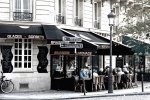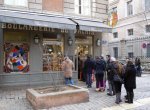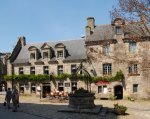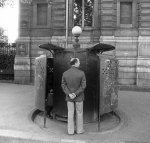champs-elysÉes (paris)
Formerly a field and a market garden, the Champs-Elysées is one of the most famous avenues in the world, and, according to many, la plus belle avenue du monde ('...the most beautiful avenue in the world').
© Atout France/Jean François Tripelon-Jarry
At its western end the avenue is bordered by cinemas, theatres, cafés and luxury shops, and described in a 1951 guidebook as possessing '...gown shops, covered arcades where one may take coffee, buy an evening gown or a goldfish, a Persian carpet or English cutlery.' With its café terraces, cosmopolitan crowds and beautiful woman, this is a quintessential artery of Paris, a magnificent thoroughfare to which you would do less than justice if you did not walk from one end to the other.
Near the Place de la Concorde, where there are neither shops now great hotels, the street is bordered by the Jardins des Champs-Elysées, beautifully arranged gardens with fountains and grand buildings including the Grand and Petit Palais at the southern side and, at its northern side, the Elysée Palace, the residence of French Presidents since 1873.
© Atout France/Nathalie Baetens
The Place de la Concorde itself was consecrated to the glory of Louis XV, and the site where his successor was guillotined. Here, too, fell the head of Parisian Lavoisier (1743-1794), a nobleman prominent in the histories of chemistry and biology, of whom the judge who condemned him said: 'The Republic does not need scientists', even though this particular scientist named both oxygen (1778) and hydrogen (1783), predicted silicon (1787), helped construct the metric system, put together the first extensive list of elements, and helped to reform chemical nomenclature. Here it was, too, that Madame Marie-Jeanne Phlippon Roland (1754-1793), a supporter of the French Revolution, at her execution cried 'Liberty, what crimes are committed in thy name?' And when the blood of the hapless and headless had been swilled away, and the rolling of the drums and the cries of the sans-culottes – the radical left-wing partisans of the lower classes – had died away, the Place was renamed...de la Concorde. Today, it is one of the most beautiful places in Paris, ornamented by two Roman fountains, two neo-Greek temples and an Egyptian obelisk.
© Atout France/Nathalie Baetens
The avenue is used for all the major celebrations. This is where Parisians celebrate New Year's Eve, and where the military parades are held. Historic national events, like the Liberation at the end of the Second World War or the victory in the World Cup football were also celebrated on this wide avenue....and, of course, the conclusion of the Tour de France cycling race.
In the 16th century, this area was nothing but fields. In 1616, Marie de Medicis decided to create a long tree-lined path going east from the Tuileries. The route was redesigned in 1667 by renowned landscape designer André Le Nôtre as an extension of the Jardins des Tuileries. The promenade, now called 'Grande Allée du Roule' or 'Grand-Cours' had become a fashionable place but was still isolated from the city with few buildings surrounding the area. Twenty-seven years later the promenade was renamed to 'Champs-Elysées', or Elysian Fields in English, the place of the blessed dead Greek mythology.
In 1724, the Champs-Elysées was extended all the way to the Chaillot hill (known today as l'Étoile, the site of the Arc de Triomphe). Its current form took shape in 1838 when French architect Ignaz Hittorf – who was redesigning the Place de la Concorde – created the Jardins des Champs-Elysées. He also installed sidewalks, gas lamps and fountains. The Champs-Elysées started to attract more and more restaurants and hotels, especially after 1900 when the Paris Métro line reached the Étoile station.
Recent Articles
-
French Food and Drink - No BS Guide for lovers of Food, Wine, Liqueurs
Aug 28, 19 03:18 AM
Our guide to French food and drink for those who love traditional French food along with our no BS guide to understanding French wine and liqueurs
-
Things To Do In Carcassonne The Ultimate Tourist Guide
Aug 24, 19 06:26 PM
The ultimate tourist guide to things to do in Carcassonne when you visit this wonderful town in Aude France. Discover the places to go and see in Carcassone.
-
Lyon Old Town Guide to Vieux Lyon
Aug 18, 19 07:48 AM
Your complete guide to Lyon old town otherwise known as the Vieux Lyon. Don't miss this amazing part of the city if you're visiting Lyon in France.
-
18 French Villages You Must Visit Most Beautiful Villages in France
Aug 17, 19 06:31 AM
Our guide to the 18 most beautiful French villages you simply must visit. Loads of info, photos and facts in our ultimate villages in France tourist guide
-
What a Pissoir - The True Story of France's Unique Urinals
Aug 13, 19 03:47 PM
Is there anything more French than a pissoir? Sadly on the decline nevertheless the pissor is an endring image of the country. This is their story





